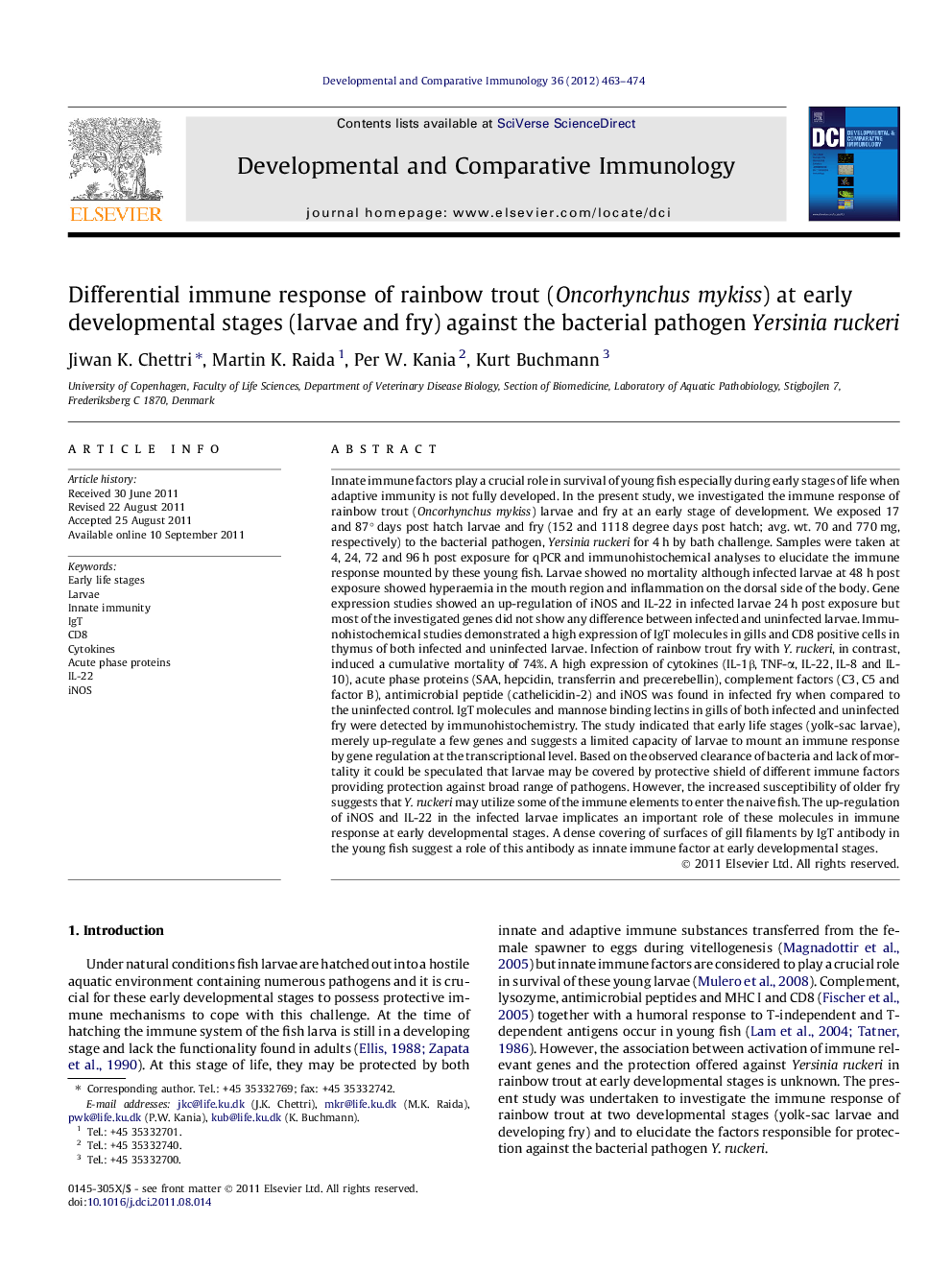| کد مقاله | کد نشریه | سال انتشار | مقاله انگلیسی | نسخه تمام متن |
|---|---|---|---|---|
| 2429620 | 1106508 | 2012 | 12 صفحه PDF | دانلود رایگان |

Innate immune factors play a crucial role in survival of young fish especially during early stages of life when adaptive immunity is not fully developed. In the present study, we investigated the immune response of rainbow trout (Oncorhynchusmykiss) larvae and fry at an early stage of development. We exposed 17 and 87° days post hatch larvae and fry (152 and 1118 degree days post hatch; avg. wt. 70 and 770 mg, respectively) to the bacterial pathogen, Yersiniaruckeri for 4 h by bath challenge. Samples were taken at 4, 24, 72 and 96 h post exposure for qPCR and immunohistochemical analyses to elucidate the immune response mounted by these young fish. Larvae showed no mortality although infected larvae at 48 h post exposure showed hyperaemia in the mouth region and inflammation on the dorsal side of the body. Gene expression studies showed an up-regulation of iNOS and IL-22 in infected larvae 24 h post exposure but most of the investigated genes did not show any difference between infected and uninfected larvae. Immunohistochemical studies demonstrated a high expression of IgT molecules in gills and CD8 positive cells in thymus of both infected and uninfected larvae. Infection of rainbow trout fry with Y. ruckeri, in contrast, induced a cumulative mortality of 74%. A high expression of cytokines (IL-1β, TNF-α, IL-22, IL-8 and IL-10), acute phase proteins (SAA, hepcidin, transferrin and precerebellin), complement factors (C3, C5 and factor B), antimicrobial peptide (cathelicidin-2) and iNOS was found in infected fry when compared to the uninfected control. IgT molecules and mannose binding lectins in gills of both infected and uninfected fry were detected by immunohistochemistry. The study indicated that early life stages (yolk-sac larvae), merely up-regulate a few genes and suggests a limited capacity of larvae to mount an immune response by gene regulation at the transcriptional level. Based on the observed clearance of bacteria and lack of mortality it could be speculated that larvae may be covered by protective shield of different immune factors providing protection against broad range of pathogens. However, the increased susceptibility of older fry suggests that Y. ruckeri may utilize some of the immune elements to enter the naive fish. The up-regulation of iNOS and IL-22 in the infected larvae implicates an important role of these molecules in immune response at early developmental stages. A dense covering of surfaces of gill filaments by IgT antibody in the young fish suggest a role of this antibody as innate immune factor at early developmental stages.
► Rainbow trout larvae and fry showed a differential immune response to Yersiniaruckeri.
► High expression of IL-22 and iNOS was observed in the infected larvae.
► A dense covering of IgT in gill filaments of the young fish suggest an important role of this antibody.
► CD8+ cells were found in the thymus of 17 days post hatch larvae.
► Increased susceptibility of fry indicates that Y. ruckeri may utilize some of the immune elements.
Journal: Developmental & Comparative Immunology - Volume 36, Issue 2, February 2012, Pages 463–474